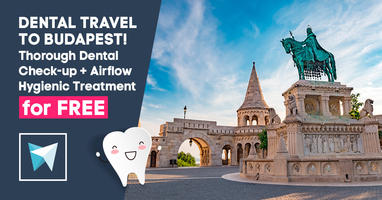Budapest has been labelled Bridge City time and time again, because the image of the bridge is perhaps the one that best describes the physical and historical realities of Hungary. Hungary is a bridge between the East and the West both on the map, and historically as well. It is also full of bridges and if you are getting some dental implants abroad, why not take some time to view the Danube from some of the most beautiful spots available?

The Danube
The Danube is a very important aspect of Budapest, with the main cultural heritage of the city being centred around it. Altogether 9 bridges span the Danube, and most of them can serve as a beautiful tourist destination while you recover from your dental implant.
Margaret Bridge
The Margaret bridge is perhaps the most famous of all of the bridges of Budapest. It connects Pest and Buda, and has the Margaret Island, one of the larger islands on the Danube in the centre. The 4 and 6 tram goes along this bridge, and this provides one of the loveliest views of the Danube corso and the Castle Hill.
Chain Bridge
The Chain bridge is located in the centre of the city, and is also very famous. It was designed by Adam Clark right after the 1848 revolution, as Budapest had just one bridge at that time. This is one of the first fully suspended bridges, and is part of the UNESCO world heritage. A must see, as it is an iconic Budapest site.
Elizabeth Bridge
The most important bridge in terms of traffic, as the brunt of the traffic that goes through and in Budapest goes through this bridge, and almost all of the commercial traffic happens through this bridge. It has some of the most beautiful surroundings, as the Ferenciek tere, a popular meeting point and architectural wonder is connected with the foothills of the Gellért hills and the Tabán, a giant park on the Buda side with some of the richest history in the city.
Freedom Bridge
The third bridge to be built in Budapest, this one carries the 47 and 49 trams across, and is responsible for much of the traffic in the south of the city. It is beautifully made, and is the main sight from the Gellért hills, as it connects the Gellért hills with downtown Pest.
Petőfi Bridge
This bridge was built in the 30s to accommodate the ever increasing tram networks throughout Budapest. It runs through the centre of town, and is important for transportation purposes, it is perhaps the most nondescript of all of the inner city bridges in Budapest.
Rákóczi Bridge
This bridge was recently renamed when the current government took to power and renamed many things in this city in 2011. This is a very useful bridge, and the view from it is spectacular, as you can see the entire city aside from the southernmost districts from here. It also connects a giant university campus to the Boráros tér, a very important southern transportation hub.
Árpád Bridge
This soviet style bridge is not much to look at, but the view from the bridge is breathtaking. Connecting the 3rd district with the illustrious 13th, and also touching the northern most tip of the Margaret Island and the Ó budai islands, this is favourite for joggers and bicyclists as it is easy to traverse on foot, but it is extremely busy, with over 150 000 vehicles passing over it daily. The 1 tram crosses the Árpád híd, as well as several bus routes.
Megyeri Bridge
The Megyeri bridge is the youngest of the bridges, and serves to connect the northern suburbs with each other. It is very out of the way, but is quite a sight, as the pillars that hold up the bridge and the mouth of the bridge give off a sense of industrial strength.
Northern Railway Bridge
This bridge can only be crossed with a train, and gives a view of the entirety of Budapest as the train enters the city from the North.
Special dental offer for those who decide to travel!
The offer is valid until 31st of December, 2019.


